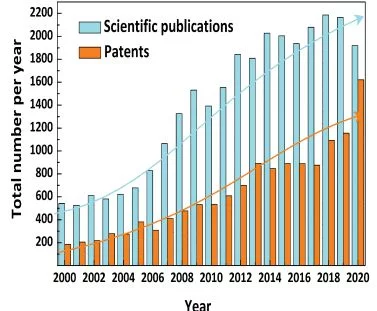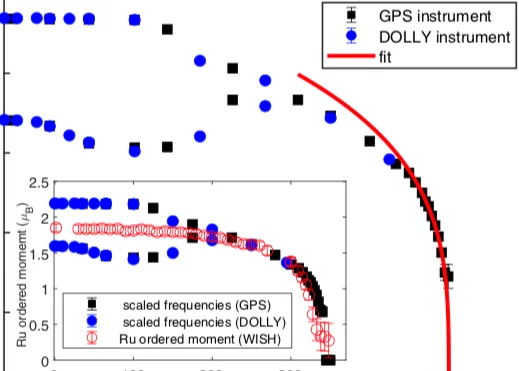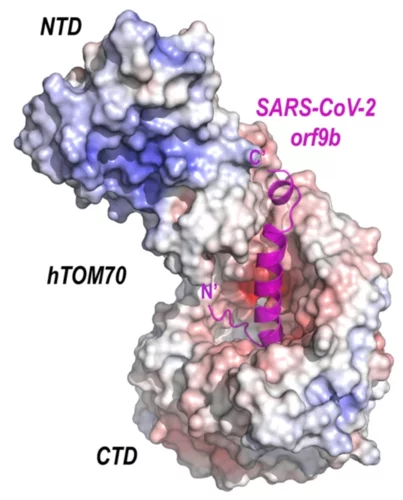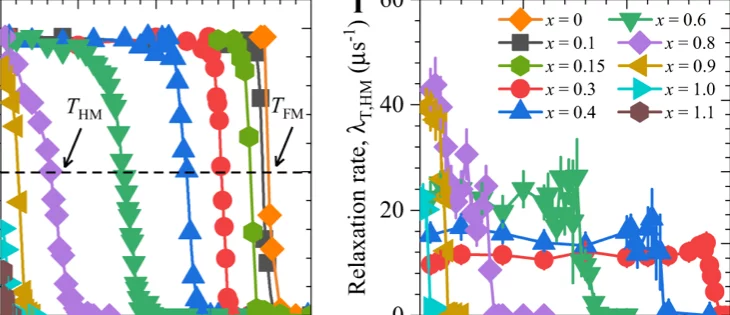At PSI, several projects are dedicated to important research questions concerning the Sars-CoV-2 coronavirus and the resulting diseases. We provide information on activities and projects, for example on investigations of lung tissue, on the production of proteins and antibodies or on ideas for new research on Covid-19.
Useful links
Giant phonon anomalies in the proximate Kitaev quantum spin liquid α-RuCl3
The Kitaev quantum spin liquid epitomizes an entangled topological state, for which twoflavors of fractionalized low-energy excitations are predicted: the itinerant Majorana fermion and the Z2 gauge flux. It was proposed recently that fingerprints of fractional excitations are encoded in the phonon spectra of Kitaev quantum spin liquids through a novel fractional- excitation-phonon coupling. Here, we detect anomalous phonon effects in α-RuCl3 using inelastic X-ray scattering with meV resolution.
How catalysts age
Catalysts used in industry change their material structure over the years. Using a new method, PSI researchers have now studied this on the nanoscale.
Rare earth for digitization and e-mobility
The importance of rare earths has increased steadily in recent years - and so has their demand. Digitization and e-mobility in particular heavily rely on rare earth elements. However, Europe is heavily dependent on China in this area, where a large proportion of the current worldwide rare earths supply is sold from.
The PSI-EPFL spin-off REMRETEch is focusing precisely on this and is dedicated to the commercialisation of rare earth recycling. REMRETEch isolates rare earths from electrical scrap with its promising and scalable technology. The start-up has already taken first steps out of the laboratory and is currently working on a pilot project:
On-demand sample delivery article highlighted in "Applied Physics Letters"
An article on the on-demand sample delivery and protein crystallography using acoustic levitation has been selected in an Applied Physics Letters collection of papers on technology and application of acoustic tweezers.
Stable Palladium Oxide Clusters Encapsulated in Silicalite-1 for Complete Methane Oxidation
Encapsulation of highly dispersed palladium oxide clusters in the microporous channels and voids of the nanosized silicalite-1 crystals has been achieved by using an amine-based ligand.
Catching Alzheimer's Toxin
Single-particle cryo-electron microscopy of a functional Aβ42 pore equivalent, created by fusing Aβ42 to the oligomerizing, soluble domain of the α-hemolysin toxin, offers new insights into structure and function of proteins forming amyloid aggregates in Alzheimer’s disease.
“Without these technologies, we will hardly achieve our climate targets”
To achieve carbon neutrality, technologies need to be deployed which remove carbon dioxide from the atmosphere.
Roadmap on Magnetoelectric Materials and Devices
The possibility of tuning the magnetic properties of materials with voltage (converse magnetoelectricity) or generating electric voltage with magnetic fields (direct magnetoelectricity) has opened new avenues in a large variety of technological fields, ranging from information technologies to healthcare devices and including a great number of multifunctional integrated systems, such as mechanical antennas, magnetometers, and radio frequency (RF) tunable inductors, which have been realized due to the strong strain-mediated magnetoelectric (ME) coupling found in ME composites. The development of single-phase multiferroic materials (which exhibit simultaneous ferroelectric and ferromagnetic or antiferromagnetic orders), multiferroic heterostructures, as well as progress in other ME mechanisms, such as electrostatic surface charging or magneto-ionics (voltage-driven ion migration), have a large potential to boost energy efficiency in spintronics and magnetic actuators. This article focuses on existing ME materials and devices and reviews the state of the art in their performance.
Magnetic and electronic ordering phenomena in the Ru2O6-layer honeycomb lattice compound AgRuO3
The silver ruthenium oxide AgRuO3 consists of honeycomb Ru25+O62− layers and can be considered and can be considered an analogue of SrRu2O6 with a different intercalation. We present measurements of magnetic susceptibility and specific heat on AgRuO3 single crystals, which reveal a sharp antiferromagnetic transition at 342(3) K. The electrical transport in single crystals of AgRuO3 is determined by a combination of activated conduction over an intrinsic semiconducting gap of ≈100 meV and carriers trapped and thermally released from defects.
Crystal structure of SARS-CoV-2 Orf9b in complex with human TOM70 suggests unusual virus-host interactions
In a study published in Nature Communications, researchers at the NHC Key Laboratory of Systems Biology of Pathogens in Beijing, China, in collaboration with the Paul Scherrer Institut characterize the interactions of SARS-CoV-2 orf9b and human TOM70 biochemically, and they determine the 2.2 Å crystal structure of the TOM70 cytosolic domain with a bound SARS-CoV-2 orf9b peptide.
Understanding Why Solid-State Batteries Fail
Researchers from the University of Oxford, the Diamond Light Source and the Paul Scherrer Institut have generated strong evidence supporting one of two competing theories regarding the mechanism by which lithium metal dendrites grow through ceramic electrolytes. A process leading to short circuit at high rates of charge. The X-ray phase-contrast imaging capabilities of the TOMCAT beamline of the Swiss light source allowed researchers to visualize and characterize the growth of cracks and dendrites deep within an operating solid-state battery. The results were published in Nature Materials on April 22, 2021.
High-resolution neutron imaging reveals kinetics of water vapor uptake into a sessile water droplet
Various imaging methods in materials research have pursued the characterization of material composition and its change in space and time. When it comes to liquid matter far from equilibrium, such as mixing and evaporating mixtures of solutes and solvents, of paramount importance in diverse solution-processing methods, the quantitative and in situ characterization remains challenging. Our research with the evaporating ...
The glacial memory of the Monte Rosa
The next mission to preserve the climate heritage of the Pennine Alps has begun: For the Ice Memory Project, researchers set off for Monte Rosa’s Colle Gnifetti.
New class of substances for redox reactions
The step-wise oxidation of a new redox-active molecular semiconductor is recognized by changing shape, assembly behavior and other properties by spectro-microscopy correlation.
Application of synchrotron-XRPD to protein powders
Breakthrough applications of high-resolution and high-counting statistics synchrotron X-Ray Powder Diffraction to protein powders leading to the determination of a 1.8 structural model of the pharmaceutical peptide "octreotide" - the highest resolution ever achieved for a peptide of this complexity using X-ray powder diffraction and crystallographic methods.
A "magical" power with major impact
Microrobots, materials with shape memory, and better particle accelerators are made possible through the exploration of magnetism at PSI.
Quantifying oriented myelin in mouse and human brain
Myelin 'insulates' our neurons enabling fast signal transduction in our brain. Myelin levels, integrity, and neuron orientations are important determinants of brain development and disease. Small-angle X-ray scattering tensor tomography (SAXS-TT) is a promising technique for non-destructive, stain-free imaging of brain samples, enabling quantitative studies of myelination and neuron orientations, i.e. of nano-scale properties imaged over centimeter-sized samples.
Laser-induced transient magnons in Sr3Ir2O7 throughout the Brillouin zone
Ultrafast manipulation of magnetic states holds great promise for progress in our understanding of new quantum states and technical applications, but our current knowledge of transient magnetism is very limited. Our work elucidates the nature of transient magnetism in gapped antiferromagnets using Sr3Ir2O7 as a model material. We find that transient magnetic fluctuations are trapped throughout the entire Brillouin zone while remaining present beyond the time that is required to restore the original spin network.
Forschung zu Covid-19
Am PSI arbeiten Forschende aus aller Welt daran, Massnahmen gegen das Virus zu entwickeln. Sie wollen besser verstehen, wie das Virus in den menschlichen Körper und seine Zellen gelangt, wie es verschiedene Organe, zum Beispiel die Lungen, schädigt und welche Medikamente am besten gegen das Virus wirken. Dazu werfen sie tiefe Blicke in Gewebe und analysieren die Bausteine des Virus sowie die Struktur vielversprechender Wirkstoffe.
Im Filmbeitrag erklären Forschende ausserdem, wie das Virus durch Aerosole übertragen wird, ob ein Malaria-Medikament auch bei Covid-19 helfen kann und wie man den Aufbau und die Wirkweise von Medikamenten entschlüsselt.
Multiple quantum phase transitions of different nature in the topological kagome magnet Co3Sn2−xInxS2
The exploration of topological electronic phases that result from strong electronic correlations is a frontier in condensed matter physics. One class of systems that is currently emerging as a platform for such studies are so-called kagome magnets based on transition metals. Using muon spin-rotation, we explore magnetic correlations in the kagome magnet Co3Sn2−xInxS2 as a function of In-doping, providing putative evidence for an intriguing incommensurate helimagnetic (HM) state. Our results show that, while the undoped sample exhibits an out-of-plane ferromagnetic (FM) ground state, at 5% of In-doping the system enters a state in which FM and in-plane antiferromagnetic (AFM) phases coexist.
Eine Woche im Leben eines Elektroniklernenden
Wie sieht die Arbeitswoche eines Elektroniklernenden aus? Was macht sie in der Schule? An welchen Projekten arbeitet er? All diese Fragen werden von Sergio und Susanne beantwortet.
No rose-coloured glasses here
Light is essential for life, and for researchers it is also a wonderful tool to better understand the structure of materials.
Excellent cycling stability of graphite in all-solid-state battery using sulfide solid electrolyte
All-solid-state lithium ion batteries represent a promising battery technology for boosting the volumetric energy density and promising a superior safety. In this study excellent cycling stability of graphite anode material have been demonstrated in combination with sulfide-based solid electrolyte. Furthermore we evaluated the stability of the graphite-electrolyte interface by analyzing the normalized cumulative irreversible charge during cycling experiments.
How remdesivir works against the coronavirus
Researchers at Goethe University Frankfurt, in cooperation with the PSI have probably discovered another, previously unknown mechanism of action of the antiviral remdesivir.
Information for SmuS users
If you are not able to come to PSI, please contact the corresponding instrument scientist as early as possible to discuss if and how the experiment could be conducted by the PSI staff members.
Christian Bauer interviewed on Electric Cars at the program Einstein by SRF
Christian Bauer, a scientist at PSI's Laboratory for Energy Systems Analysis who specialises in life cycle and sustainability analyses, interviewed at the program Einstein by SRF on Electric Cars
Combating antimicrobial resistance
In a study addressing the global health threat of drug resistance, researchers at the Biozentrum, University of Basel, have revealed how a new antibiotic, Darobactin, binds to the external membrane of gram-negative bacteria.
X-ray ptychographic topography: A robust nondestructive tool for strain imaging
We present x-ray ptychographic topography, a method for strain imaging, and demonstrate its use on an InSb micropillar after microcompression, where the strained region is visualized with a spatial resolution of 30 nm.
Cell cytoskeleton as target for new active agents
Using a combination of computer simulations and laboratory experiments, PSI researchers have identified new binding sites for active agents on the vital protein tubulin.
Deep evolutionary origins of the human smile
Detailed characterization of the tooth and jaw structure and development among shark ancestors by synchrotron based X-ray tomographic microscopy at TOMCAT led an international team of researchers from the Naturalis Biodiversity Center in Leiden and the University of Bristol to the discovery that while teeth evolved once, complex dentitions have been gained and lost many times in evolutionary history.





























